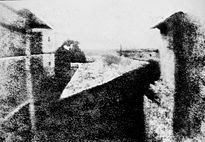One summer day in France in 1826, Joseph Niepce took the world's first photograph. It's a photo of some farm buildings and the sky. It took an exposure time of 8 hours. Voila! It had to feel pretty incredible, like magic.
No one's exactly sure how he did this or what chemicals were used. All that's known for sure is that the photo is on an 8"x 6.5" pewter plate. It's so faint it has to be tilted in order for the light to catch it just right, to see it. The Getty Museum in California did two weeks of tests in 2003 in a joint project involving the Rochester Institute of Technology and France's Centre de Recherches sur la Conservation des Documents Graphiques (try saying that three times fast). Then it went back on display at the University of Texas in a new air tight case, where it's been on display since 1964. I'm not sure why we have it and the French don't, but "hah".
The current theory about how the photograph was taken is that Niepce coated the pewter plate with bitumen, a petroleum derivative sensitive to light. After it spent those 8 hours hardening, he washed the plate with a mixture of oil of lavender and white petroleum. This dissolved the portions of the bitumen that didn't 'see' direct light, so didn't harden. Pretty damn clever. Niepce called his work a "heliograph," in a tribute to the power of the sun.Well we have come a long way since that day, today you can do a million different things with your photos. At http://Imageisus.com your photos or images can create hundreds of different products.
skip to main |
skip to sidebar

People are fascinated with pictures,I know I am.I process more from what I see then what I hear or read.Art has been with us for thousands of years.Today so much of our world is dependent on visualization,and millions of dollars a year are spent on Photography,let's face it,we love our pictures.
The first photo


No comments:
Post a Comment